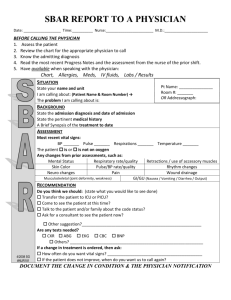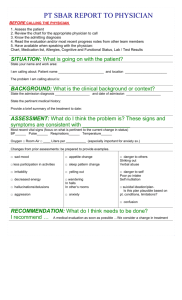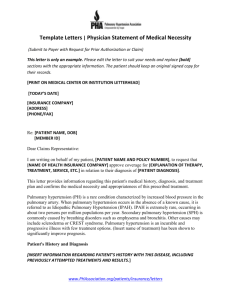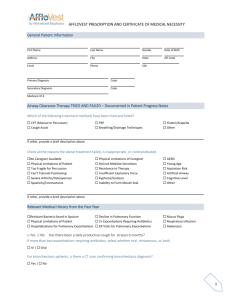Respiratory case studies with answers
advertisement
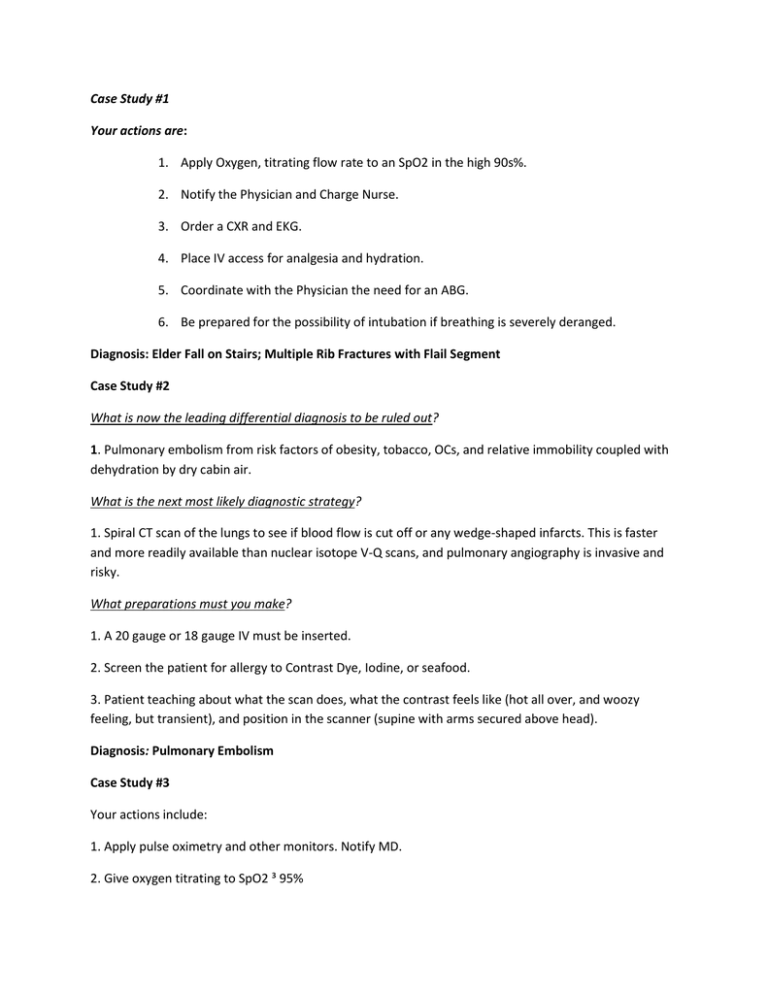
Case Study #1
Your actions are:
1. Apply Oxygen, titrating flow rate to an SpO2 in the high 90s%.
2. Notify the Physician and Charge Nurse.
3. Order a CXR and EKG.
4. Place IV access for analgesia and hydration.
5. Coordinate with the Physician the need for an ABG.
6. Be prepared for the possibility of intubation if breathing is severely deranged.
Diagnosis: Elder Fall on Stairs; Multiple Rib Fractures with Flail Segment
Case Study #2
What is now the leading differential diagnosis to be ruled out?
1. Pulmonary embolism from risk factors of obesity, tobacco, OCs, and relative immobility coupled with
dehydration by dry cabin air.
What is the next most likely diagnostic strategy?
1. Spiral CT scan of the lungs to see if blood flow is cut off or any wedge-shaped infarcts. This is faster
and more readily available than nuclear isotope V-Q scans, and pulmonary angiography is invasive and
risky.
What preparations must you make?
1. A 20 gauge or 18 gauge IV must be inserted.
2. Screen the patient for allergy to Contrast Dye, Iodine, or seafood.
3. Patient teaching about what the scan does, what the contrast feels like (hot all over, and woozy
feeling, but transient), and position in the scanner (supine with arms secured above head).
Diagnosis: Pulmonary Embolism
Case Study #3
Your actions include:
1. Apply pulse oximetry and other monitors. Notify MD.
2. Give oxygen titrating to SpO2 ³ 95%
3. Intravenous access; Draw & Send Labs.
What do you do now?
4. If patient is deeply unresponsive, hypoxic, or hypoventilating, consider going to the Code Room or
using an O2BVM.
5. Naloxone trial with incremental doses titrating to level of respirations and level of consciousness
seeking to avoid Acute Withdrawal Syndrome and "giving back the pain".
6. The patient may need admission for Naloxone drip and pain management.
Diagnosis: Excess Narcotics
Case Study #4
1. Extrinsic compression of trachea by tumor.
2. Superior Vena Cava Syndrome (may be complicated by cerebral edema)
Your actions are:
1. Notify Attending Physician & Charge Nurse
2. Order stat. Portable Chest X-Ray
3. Apply Pulse Oximetry and Monitors
4. Apply Oxygen, titrating flow rate to SpO2=100%
5. Intravenous access; two lines if possible.
This patient may need the "Code Room" because:
1. Available airway lumen may have reached a critical stenosis.
2. The patient may need intensive respiratory therapy (Bronchodilators, Racemic
Epinephrine, Heli-Ox may be temporizing)
3. Intubation may be difficult.
4. Anesthesia may need to be paged for "Difficult Airway Cart".
5. Optimal airway investigation and control may need to be fiberscopic.
Other measures may be:
1. Stat. Thoracic CT scan
2. Potential emergent radiation therapy
3. Potential emergent chemotherapy
4. Potential emergent surgery or tracheostomy.
Diagnosis: Extrinsic Airway Compression by Tumor
Case Study #5
1. Notify the Attending Physician and Charge Nurse of your concern.
2. Recheck the patient.
In the last five minutes, the SpO2 (on 2 lpm NC) has gone from 97% to 92%, the patient looks pale and
appears to be breathing with greater effort and does not look about the room to track activities.
What do you do now?
1. Apply a 100% O2 Non-Rebreather Mask which seems to perk up the patient and SpO2 rises to 96%.
2. Take the patient (with O2, etc.) to the "Code Room." Summon the Attending Physician, repeat the
EKG, and call for a stat. portable CXR.
In these five minutes, it seems that you can now hear an audible sound of wet breathing pervade the
room. Another nurse arrives at the same time as the physician, you ask the nurse for a second IV access.
What are the orders you expect to hear from (or ask for) the physician?
1. Nitroglycerin, sub-lingual, or spray.
2. Chewable Aspirin, (81 mgmsX4=324 mgms)
3. Lasix® (Furosemide), IV, (40mgms, if not taking, or double the daily dose if already taking).
{What drug allergy should you be aware of? [Sulfa—Lasix is a sulfonamide]}
{What precaution should you take in administration? [Push slowly due to ototoxicity]}
4. Morphine 2 – 4 mgs IV
Now the patient’s breathing is louder and more distressed. You ask for a Foley Catheter order. The MD
looks worried.
The next order is for:
1. Nitroglycerin infusion, titrate to effect.
SpO2 is 93%, extremities are cool and pale with some lenticular mottling noticeable. The patient moves
somewhat with noxious stimulus but is no longer verbal.
The next actions should be:
1. "Call for Respiratory!"
2. Respiratory applies a BiPAP machine.
3. Prepare for endotracheal intubation.
After the patient is intubated, while the tube is being secured, you notice a pink frothy fluid in the
endotracheal tube.
What is this?
1. Pulmonary edema fluid.
What should you do about it?
1. Suction thoroughly, in short intervals to minimize the periods of negative pressure within the airway
and to
maximize periods of oxygenation and positive pressure.
2. Expect, or have the Respiratory Therapist ask for, ventilator orders to include values for PEEP
(positive end-expiratory pressure) and Pressure Support (inspiratory positive pressure).
3. Expect further orders regarding cardiac drips. Keep an eye on the patient’s blood pressure to avoid
precipitous drops.
4. Determine the Physician’s disposition for the patient, Intensive Cardiac Care Unit or Cardiac
Catheterization Laboratory.
Diagnosis: Acute Fulminating Pulmonary Edema


